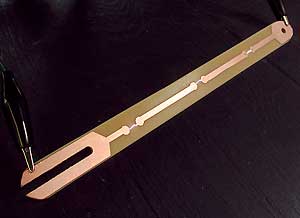
|
This is our final version of the spark strip which is etched into a strip of copper clad circuit board. The working gap is exactly 12 mm and conducts fat, reliable sparks. A swallow tail is cut at one end to provide fast installation and flexibility of launcher electrode placement. This printed circuit board (PCB) strip was made of copper clad board which was cut into shape with a knife, drill and file. The copper lines are called traces, these areas are covered with rub down transfers to protect them. The whole PCB is then soaked in a chemical which removes the unprotected copper.
|